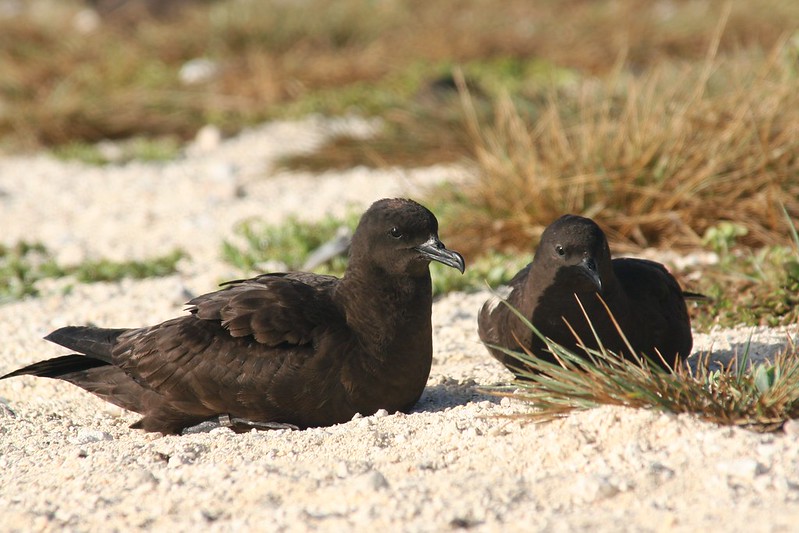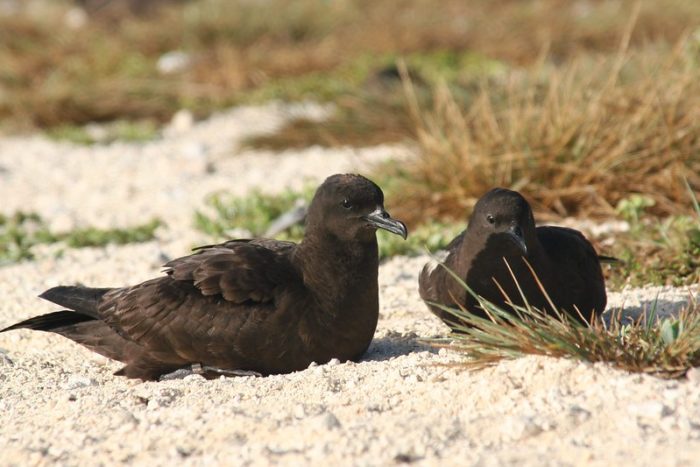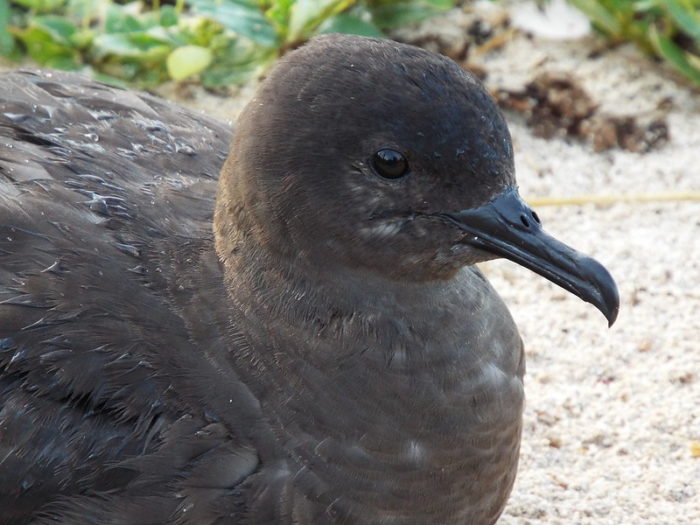
Sea Wonder: Christmas Shearwater

Photo credit: Duncan
Named not for the holiday but for Christmas Island (now known as Kritimati), close to the Equator and south of the Hawaiian Islands, Christmas Shearwaters nest on remote islands in the Pacific and are often seen by boats sailing from the Hawaiian Islands. They are called ‘ao’ū in native Hawaiian.
Description
The Christmas Shearwater (Puffinus nativitatis) is a medium-sized seabird with a short, rounded tail, a hooked, black bill, dark brown legs, and long wings. Adults are almost entirely brown, though the feathers on their underside tend to be lighter than those up top. They can grow to lengths of about 15 inches and have a wingspan nearly twice that, between 28 and 32 inches across. When fully grown, they weigh a little less than a pound. When in flight, they use several fast, stiff wing beats followed by longer glides powered by air currents. Their vocalizations are similar to wedged-tail shearwaters but more nasally and gurgly at the start of their calls.
Diet & Habitat
Christmas shearwaters feed on fish and invertebrates, mostly squid but sometimes crustaceans or marine worms. They feed from the surface by snatching prey up as they float along with the current or by diving into shallower waters. Occasionally, while flying, these birds will see an opportunity to hunt and will dip down or pick prey from the water while in flight. Christmas shearwaters tend to forage in larger flocks of multiple species, usually birds that follow larger fishes like tuna, which chase smaller fish to the surface. Christmas shearwater chicks eat stomach oil and partially digested fish provided by their parents and will eat as often as once every 24 hours for their first two months of life or so.
Christmas shearwaters are a rare sight from the shores of the Hawaiian Islands but are often seen by boats offshore. This seabird species is marine and pelagic, meaning they mostly travel over warm and deeper waters, keeping away from land except for when they are nesting. They travel in pairs or small flocks off of the Southeastern Hawaiian Islands, including Kaua’i, O’ahu, and Hawai’i. They nest on remote islands in the central Pacific Ocean, including the Hawaiian Islands, Phoenix Island, the Marquesas Islands, and Easter Island. In the National Marine Sanctuary System, they travel through both Hawaiian Islands Humpback Whale National Marine Sanctuary and Papahānaumokuākea Marine National Monument.
Life History
This species of shearwater breeds throughout the Tropical Pacific with the Northwestern Hawaiian Islands serving as the northernmost point in their breeding range. Each year, nearly 3,000 mating pairs of Christmas shearwaters nest and breed in the Northwester Hawaiian Islands alone. More than half of these nests occur on Laysan Island, followed by Lisianski, Nihoa, Midway, Kure, French Frigate, and Pearl and Hermes. Christmas shearwaters tend to build nests along slopes, including rocky hillsides or in lava fields throughout the islands. Nests are simple and built from twigs, leaves, and other vegetation. In somewhat rare cases, birds will nest in already available spots like in piles of driftwood, under buildings, or in abandoned burrows.
These birds, like many others, are believed to be monogamous, mating with the same partner each year, though “divorce” is more common in this species of seabird than others. Their maximum lifespan is thought to be around 11 years old. Christmas shearwaters are most active in courtship behavior around dawn before foraging for most of the day. They return to their nests around dusk and are active at night; during the day they are quiet and at rest when on land, and therefore rarely seen in their nests. Like most species of seabird, Christmas shearwaters return to the same nesting area where they hatched. Females lay one egg per season and both parents participate in guarding the eggs and caring for hatchlings. Incubation lasts between 50 and 60 days on average and shearwater hatchlings take about 100 to 120 days to grow and fledge, a milestone that involves leaving their nest, providing for themselves, and socializing with other juvenile birds. Mating season often begins in late February with egg laying occurring by the start of May. Shearwaters leave their nesting grounds by November and return in the spring.
Threats & Conservation
Experts estimate a global Christmas shearwater population of around 150,000 individuals. Population health appears to be stable as there isn’t clear evidence for declines or substantial threats at the present. However, this species is vulnerable to future threats, especially those related to climate change. Given that they nest on lower-lying islands in the Pacific, Christmas shearwater nesting grounds are at risk of flooding or other inundation due to sea level rise, which increases the likelihood that these birds will have to compete with other species of seabird for space throughout their limited range. Other potential threats include marine pollution, ocean acidification, and depletion of fisheries. Depending on where they nest, Christmas shearwater eggs and chicks may be at risk to predation by rodents and feral cats.
To protect seabirds in the Pacific, management efforts include habitat conservation and preservation, reduction or elimination of non-native species, minimize bycatch and other fisheries interactions, and minimizing the influence of human infrastructure like powerlines, lights, and wind turbines. Current management efforts are federal and more localized in nature, and marine protected areas can offer an added layer of protections for Christmas shearwaters and other species. Future management efforts could improve by incorporating research outcomes like long-term monitoring data, survival and reproductive rates, and information about the range of subpopulations and individuals.

Photo credit: Forest and Kim Starr
